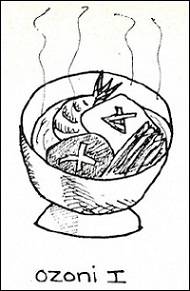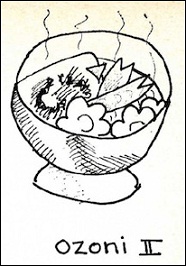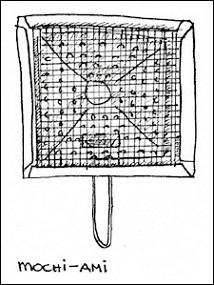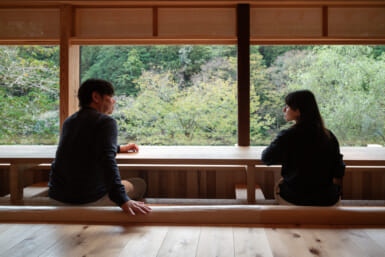with Elizabeth Andoh
Cold weather is soup weather and this month’s column will be devoted to that winter, meal-in-a-bowl soup known as ozoni.
There are hundreds of variations of ozoni throughout Japan, but basically it contains grilled or boiled omochi (pounded rice cakes; one cake equals about 3/4 bowl of rice—very filling!), vegetables and meat and/or fish.
There are three types of broth commonly used: clear dashi (basic soup stock), clear chicken broth and miso-thickened dashi.
Today’s recipes include dashi (a repeat from my first column in May, 1974) and clear chicken broth (oriental version) and two variations on the ozoni theme.
DASHI (soup stock, yields approximately 4 1/2 cups)
ingredients:
- 5-6 inches dashi konbu
- 1 cup (very loosely piled in) katsuo bushi
- 5 cups cold water
seasonings:
- 1 1/2 teaspoons usuguchi shoyu
- 1 teaspoon salt
- dash of MSG (optional)
instructions:
1. Put 5 cups fresh cold water into a fairly large pot. Add dashi konbu and bring it to a boil over high heat, uncovered.
2. Remove the konbu once the water has begun to boil. Add the katsuo bushi and turn off the heat.
3. Let it stand for one minute (the katsuo is beginning to sink) before straining through cheesecloth and a strainer into a large bowl.
4. Season just before using.
notes:
1. Konbu or dashi konbu is a kind of seaweed used to flavor soups and broths. Several long, dark strips come in small package (cost around ¥120 to ¥1,250) and these can be cut with a scissors. Keep in a dry, cool place after opening. The white film is not mold, but often sand particles cling to the konbu and therefore a gentle rinsing before use is often recommended.
2. Katsuo bushi are flakes of dried bonito fish. A small package of already shaved katsuo (looks something like wood shavings) should cost around ¥120 to ¥130, although there are all grades and qualities. Store the same as konbu.
3. Usuguchi shoyu is “light” soy sauce—the color is thinner than shoyu (regular soy sauce), but it is saltier in flavor. When buying, check the label with someone who can read Japanese (the salesclerk, for example).
4. Dashi will keep, refrigerated, for several days. It may be frozen, but with loss of flavor.
* * *
ORIENTAL CHICKEN STOCK (yields approximately 4 cups)
ingredients:
- 5 cups cold water
- 1 tori-gara
- 1 knob of fresh ginger root
- 1-2 leeks or 3-4 scallions
- 1 tablespoon salt
- 2-3 whole peppercorns
- 1 tablespoon shoyu (regular soy sauce)
- MSG (optional)
instructions:
1. Crack in several places or break in half one tori-gara. Put it in a large kettle with 5 cups cold water.
2. Add the ginger (sliced in thin slices) and the leeks or scallions (cut into 3/4″ lengths) including white and green parts.
3. Add the salt and peppercorns and bring to a boil, covered, over high heat.
4. Turn the heat down and simmer partially covered for about 40 minutes. Add the shoyu and MSG and simmer for another 10 minutes.
5. Strain the stock (and clarify it with raw egg shells if it is very cloudy).
notes:
1. Tori-gara are chicken bones and carcasses minus most of the meat; 1 set runs about ¥40 to ¥60 at almost any poultry counter.
2. Fresh ginger is called shoga. No need to peel it before slicing (if well rinsed of dirt) for this recipe.
3. Leeks are called naganegi, scallions are wakanegi (wagegi in some Tokyo dialects) or asatsuki (very thin, delicate, almost all green).
* * *
OZONI I (with clear dashi)
ingredients:
- 4 cups flavored dashi (2/3 cup per serving)
- 6 omochi (one per serving)
- 1/2 bunch horenso or komatsu
- 6 large shrimp (one per serving)
- 6 shiitake (one per serving)
- 1/4 yuzu peel
instructions:
1. Soften the omochi soaking it in warm water for 10-15 minutes. If the omochi is particularly hard, bring the water to a boil and simmer it for 1-2 minutes before removing from the heat. Let the omochi soak for a few minutes.
2. Quickly blanch well-washed horenso or komatsu in boiling salted water (1 teaspoon salt, 1 1/2 cups of water) until the vegetable is bright green and barely tender. Drain, and squeeze the vegetable of all excess moisture. Cut it into 1-2 inch lengths.
3. Shell and de-vein 6 large shrimp, but leave the tails intact. Quickly blanch the shrimp in boiling water till pink and slightly curled.
4. Gently rinse and pat dry 6 shiitake after removing the stems. If the shiitake are large, cut each in half slightly on the diagonal.
5. Heat the dashi and add the shiitake, allowing them to cook in barely simmering liquid for 1-2 minutes.
6. Arrange the following in each of 6 individual bowls: one softened omochi, one shrimp, one bundle of horenso or komatsu. Add the simmering shiitake and pour hot dashi over all.
7. Peel 1/4 of yuzu and slice the peel into 6 pieces. Float one piece on top of each bowl.
Serve hot.
notes:
1. Omochi, made from pounded glutinous rice, are sold fresh during New Years and the early part of the year. They come in small squares, rectangles or rounds. Omochi also come in vacuum packed vinyl, but the fresh product is far superior. Omochi may be tinted pink (for New Years)
or have beans or other things mixed into it.
2. Horenso is spinach; the leaves are flat, the roots are pink or red. Komatsu is a tipped, leafy vegetable resembling collard greens; the roots are white.
3. Shiitake are black mushrooms. Use fresh ones, not dried, for this recipe.
4. Yuzu is a type of citron with a marvelous aromatic peel (the fruit itself is bitter, though).
* * *
OZONI II (with oriental chicken stock)
ingredients:
- 4 cups oriental chicken stock (2/3 cup per serving)
- 6 omochi
- 12 snowpeas (salt)
- 150 grams sasami (sake, salt)
- 1/4 carrot (salt)
- 1/4 yuzu peel
instructions:
1. Grill the omochi over direct heat, turning frequently for about 5-6 minutes. The outer surface will puff up. color slightly, harden and crack, exposing the soft inside. Place one grilled omochi in each of six individual bowls.
2. Marinate the sasami in 2 tablespoons sake and teaspoon salt for 5-10 minutes. Grill the sasami over direct heat, turning frequently, until very white with some golden-charred edges (almost 8-10 minutes). Allow the chicken to cool to the point of handling; then pull apart to make many strips approximately 2-3 inches long and 1/4-1/2 inch thick. Divide these strips among the 6 bowls.
3. Wash and string the snowpeas. Blanch them in boiling salted water until bright green and barely tender. Drain and place two in each of the 6 individual bowls.
4. Peel and cut the carrot into thin decorative shapes (flowers, if possible). Quickly parboil the carrot pieces in salted water till barely tender. Drain and divide among the 6 bowls (about 2-3 per bowl).
5. Heat through the soup stock until it is very hot; pour over the contents in each bowl and float a piece of yuzu peel on top. Serve hot.
notes:
1. Sasami is chicken fillet (all white meat).
2. A special net to grill omochi and chicken directly over your gas or electric range is sold with household and kitchen goods (cost about ¥90). Get a fine meshed one, but without the white, clay-like substance on it (these dissolve with washing). They are called mochi-ami one is pictured here with fine holes covered by netting; the handle is retractable. Made of aluminum, mochi-ami discolor quickly with heat (and the handles get hot, so watch out) but this does not detract from their usability.











_KRAACH-クリスタルバスソルト-385x257.jpg)